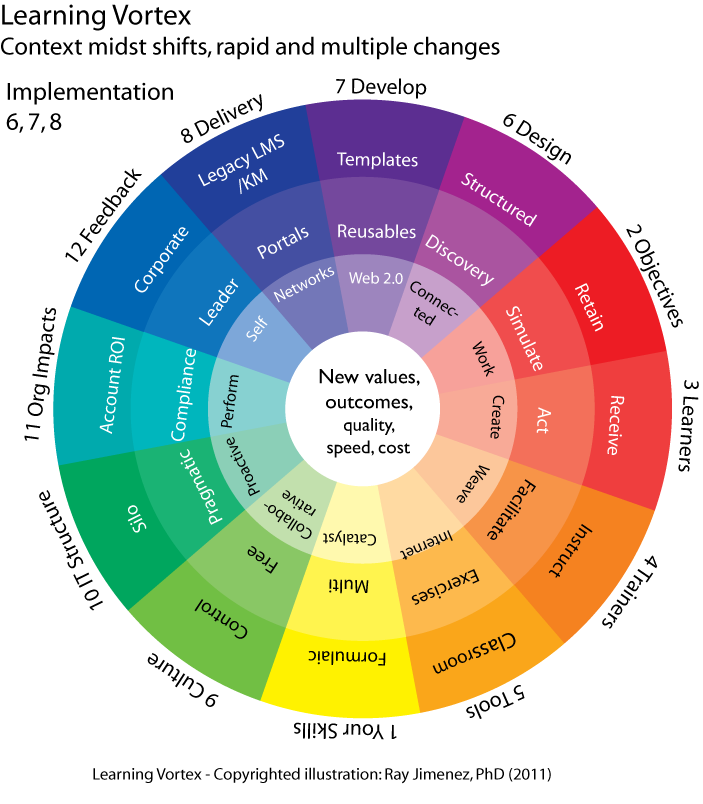The learning industry is in turmoil – like in a twister. There is constant push and pull which results to changes and adjustments. The “Learning Vortex” is an effective way of maintaining focus and keeping one’s “sanity” in the midst of the “ twister” in learning. The core of the vortex represents the impact and result of the changes – which can be clearly categorized and identified by the three other parts of the vortex
A twister is a phenomenon in our atmosphere where cold and hot air collide to create massive turbulence. In many respects, our learning world appears to be caught up in a twister. There is an abundance of change, innovation, and technologies, as well as dislocations and realignments. There is constant push and pull, as well as impacts.


The “Learning Vortex” has four parts: The Core; Learning Strategy; Implementation; and Organizational influences.
Let me share with you a few of my thoughts on each area.
The Core
The Core is the heart of the vortex. This is the strongest area where the twister creates new values and impacts the way we do things. The main impacts in today’s changes in learning are more pronounced in cutting costs and increasing speed, and refocusing the attention of trainers and learners on what is important. Preview the video of Sal Kahn and Bill Gates about Kahn Academy and you will see the inroads to creating new values. We are redefining our roles by being agnostics in our approaches.
Part 1 – Learning Strategy
Regardless of whether one starts from Part – 3 Organizational Influences or Part 1 – Learning Strategy, the learning professionals now realize that they must change their roles, skills, tools, and objectives to meet the shifting needs of learners.
1. Skills – we are becoming “Collaborative Learning Anthropologists” where we focus on using different skills sets to become catalysts of change.
2. Objectives – the focus of our efforts is how to bring learning closer to work.
3. Learners – we are seeing learners more as contributors who actively pursue their own learning interests.
4. Trainers – we are seeing more of us in the role of Network Weavers.
5. Tools – the abundance and large scale adoption of Web 2.0 tools in learning suggest our growing versatility to choose and pick the right tools for a given problem.

The design, development, and delivery of learning has been redefined by technology. Both classroom and course development are undergoing remakes that make them accessible and flexible. From mobile learning to video streaming, the focus is to provide newer experiences in learning and more opportunities to cut costs and increase speed.
6. Design – we see more Microlearning programs, courses and delivery.
7. Develop – rapid development enables trainers to get training delivered, fast.
8. Deliver – more of our learning initiatives are delivered through diverse forms of collaborative and social networking tools and methods. We also see the practical learning values of tools like Twitter and micro-widgets.

Part 3 –Influences
The “Learning Vortex” takes place in the larger context of our organizations and societies. How much change we experience and the speed at which it happens are always influenced by the nature of the business, leadership and the goals and strategies of the business. This is part of the push and pull of the “Learning Vortex”. Organizations that are seemingly slow in adapting to change often create environments where the learning professional is caught in a flux. Businesses want to reduce the costs and increase the speed of change that create new learning values, but are not prepared to embrace solutions that demand transformation in their culture and leadership. So, we see learning professionals doing guerrilla warfare – using unauthorized and unorthodox learning methods and deliveries outside of the corporate structures.
9. Culture – enterprises are complex structures and the “Learning Vortex” is most visible mainly in how enterprises use knowledge – as a central repository of information or as a living and growing knowledge base to be built and shared freely within the organization.
10. IT Structure – we see IT departments starting to adopt collaborative systems and becoming more tolerant and accepting of multiple requests from learning professionals in deploying social networks and high and rich media content delivery.
11. Organizational Impacts – convergence of technologies makes it possible to link learning to actual performance metrics in business impacts.
12. Feedback – although feedback from a traditional view suggests that trainers provide feedback on learning progress, learners are taking more and more responsibility upon themselves when it comes to their own learning. .
Conclusion
There is always rapid and constant change, especially in the things that influence learning and the learners’ needs. All the different strategies, ways of implementations, and influences change along with time and innovations in technology. The “Learning Vortex” can help us take these things into consideration and understand their effects on the core of learning. It helps strike a balance when things go out of hand. As clearly pointed out in each element, these changes are inevitable and are therefore greatly impacting the core of every learning experience, and learning need.
Ray Jimenez, PhD
Vignettes Learning
“Helping Learners Learn Their Way”
